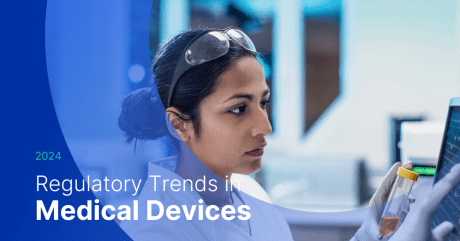
Sector Spotlight: Medical Devices Regulatory Outlook – June 2024

This blog was originally posted on 19th June, 2024. Further regulatory developments may have occurred after publication. To keep up-to-date with the latest compliance news, sign up to our newsletter.
AUTHORED BY DENISE MCDERMOTT, SENIOR REGULATORY COMPLIANCE SPECIALIST, COMPLIANCE & RISKS
Introduction
The medical device industry continues to experience a growth in regulations. Recent developments in areas such as cybersecurity and artificial intelligence coupled with growing concerns around the restriction of chemicals substances in products has led to an overall increase in regulation of the industry. Manufacturers need to continuously monitor and assess regulatory requirements to ensure compliance.
For the next quarter, here are the developments that we have flagged as potentially impacting our customers.
Key Regulations Impacting Your Industry
- USA: Quality System for Medical Device Manufacturing, 21 CFR Part 820 – Amendment – (on quality system regulation), Final Rule, 89 FR 7496, February 2024, Quality Management System Regulation
- USA: In Vitro Diagnostic Products for Human Use, 21 CFR 809, 1976 – Amendment – (on laboratory developed tests) Final Rule, 2024
- US: Artificial Intelligence and Medical Products, Guidance Document, March 2024
- EU: In Vitro Diagnostic Medical Devices, Regulation (EU) 2017/746 and Others – Amendment – (on extended transition timelines, roll-out of EUDAMED, etc.) Regulation, May 2024, 2024/0021 (COD)
- EU: Medical Devices, Regulation (EU) 2017/745 and Others – Amendment – (on transitional provisions for certain medical devices and in vitro diagnostic medical devices) Regulation (EU) 2023/607
- EU: Harmonised Rules on Artificial Intelligence, Draft Regulation, April 2021-Proposed Artificial Intelligence Act, Proposed EU AI Act
- EU: Registration, Evaluation, Authorisation and Restriction of Chemicals (REACH), Regulation 1907/2006
- IMDRF: Medical Device Software – Considerations for Device and Risk Characterization, Public Consultation, February 2024
- USA: Updates for the Premarket Cybersecurity Guidance, Draft Guidance, March 2024
- Brazil: Essential Safety and Performance Requirements for Medical Devices and In Vitro Diagnostic (IVD) Medical Devices, Portaria RDC No. 848, 2024
- Brazil: Establishing an Optimised Procedure for Analysing and Deciding on Applications for Registration of Medical Devices Through the Use of Analyses Carried Out by an Equivalent Foreign Regulatory Authority, Normative Instruction No. 290, 2024
- Brazil: Procedures for Granting Certification of Good Manufacturing Practice and Certification of Good Distribution Practice and/or Storage for Health Products and others, Resolution No. 497, 2021 – Amendment – (on validity period of certificates) Resolution RDC No. 850, 2024
- UK: Medical Devices Regulations, SI 2002/618 – Amendment – (on extending the periods during which manufacturers can place CE-marked medical devices on the GB market, etc) Regulations, SI 2023/627
- UK: Implementation of Medical Devices Future Regime, Guidance Document, January 2024
Quality Management
The US Food and Drug Administration (FDA) recently published its Quality Management System Regulation (QMSR) final rule, amending the Code of Federal Regulations; 21 CFR Part 820, by incorporating by reference, the quality management system requirements of ISO 13485. ISO 13485 specifies requirements for a quality management system for medical devices. The QMSR aims to enhance quality assurance processes within manufacturing, ultimately benefiting patients and healthcare providers. The QMSR will be effective from 2 February 2026, allowing a two-year transition period for manufacturers to ensure compliance is met, during which time, manufacturers must maintain compliance with the existing QSR.
Medical Device Availability in the EU
In order to ensure continued availability of medical devices, Regulation 2023/607 was published in the EU in 2023 which allowed additional time for manufacturers of certain medical devices to transition to the EU Medical Device Regulation (MDR). A proposal for an extension of the transitional periods for certain legacy IVDs was also published in 2024. It proposes a gradual roll-out of EUDAMED modules, and a new obligation on manufacturers to provide advance notice of disruption of supply of certain medical devices and in vitro diagnostics. The extension to the transitional periods provides additional time to transition to the new regulations and aims to ensure the continued availability of devices on the market.
Artificial Intelligence (AI)
The use of AI in the industry is growing and there is a need for regulatory frameworks to ensure safety and reliability. In the EU, new rules on artificial intelligence aim to create a new framework for regulation in this area, and will have an impact on the medical device industry. The proposed EU AI Act, expected to be finalized soon, aims to establish comprehensive rules for the use of AI, whilst ensuring safety and ethical considerations are met.
In the US, the FDA recently published a guidance document on use of AI across the medical product life cycle. This guidance outlines the FDA’s expectations for AI in device development, testing, and post-market surveillance, emphasizing transparency and patient safety.
In the UK, the Medicines and Healthcare products Regulatory Agency (MHRA) set out its strategic approach to AI in April 2024. The MHRA’s strategy focuses on fostering innovation while ensuring that AI applications in medical products adhere to stringent safety and performance standards.
Software & Cybersecurity
With software playing an increasingly important role in healthcare, it is imperative that regulations keep up with the challenges posed and regulatory harmonization is achieved. The International Medical Device Regulators Forum (IMDRF) published a consultation in 2024 entitled “Medical Device Software – Considerations for Device and Risk Characterization Consultation document”. This document aims to provide accurate characterizations of medical device software. There is a significant emphasis on risk characterization in the document, recognizing the need for improved transparency and consistency.
As software increases in complexity, the requirement to consider cybersecurity also grows. In the USA, the FDA published a draft guidance document in 2024 entitled “Select Updates for the Premarket Cybersecurity Guidance: Section 524B of the FD&C Act”. This guidance proposes updated recommendations to industry on cybersecurity considerations for “cyber devices” and information required in premarket submissions. The guidance aims to ensure that manufacturers provide adequate cybersecurity assurances by providing the necessary information required to support premarket submission obligations concerning the cybersecurity of medical devices.
Medical Device Reform
The UK Government published their Implementation of Medical Devices Future Regime Guidance Document in 2024 which describes the delivery of the future regulatory framework for medical devices. Overall, the reforms will aim to enhance the safety, performance, and quality of medical devices in the UK. Key measures for 2024 include a focus on implantable devices, healthcare AI and software. The updated regulations aim to enhance international harmonization and introduce patient-centered requirements that keep pace with technological advancements.
What’s Next?
Medical device regulation will continue to increase, with additional focus on advanced technologies. The final text of the EU AI Act and the timeline extension for IVDR transition are both expected in 2024. There will be an increased focus on cybersecurity and new regulatory approaches towards AI-based medical device cybersecurity may be required.
Stay Ahead Of Regulatory Changes
Accelerate your ability to achieve, maintain & expand market access for all products in global markets with C2P – Your key to unlocking market access, trusted by more than 300 of the world’s leading brands.
C2P is an enterprise SaaS platform providing everything you need in one place to achieve your business objectives by proving compliance in over 195 countries.
C2P is purpose-built to be tailored to your specific needs with comprehensive capabilities that enable enterprise-wide management of regulations, standards, requirements and evidence.
Add-on packages help accelerate market access through use-case-specific solutions, global regulatory content, a global team of subject matter experts and professional services.
- Accelerate time-to-market for products
- Reduce non-compliance risks that impact your ability to meet business goals and cause reputational damage
- Enable business continuity by digitizing your compliance process and building corporate memory
- Improve efficiency and enable your team to focus on business critical initiatives rather than manual tasks
- Save time with access to Compliance & Risks’ extensive Knowledge Partner network
Medical Devices Regulatory Updates in North, Central and South America
This whitepaper gives an overview of recent medical device regulatory developments in North, Central and South America to help you keep your medical devices compliant.


